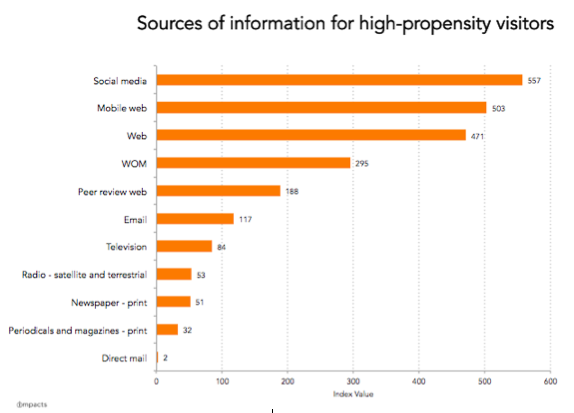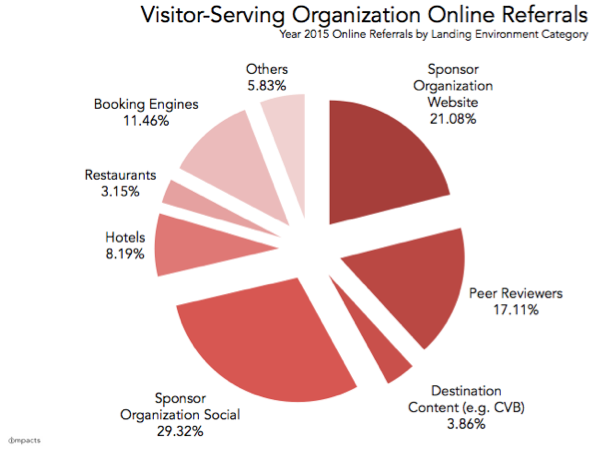
Think that your website is your organization’s most important online communications asset? Think again.
This week’s Know Your Own Bone Fast Facts video busts a myth that seems to be slow to shake for some leaders. As it turns out, your organization’s own website is not your organization’s most important online communications asset.
Organizations tend to understand that websites are important – because they are. Social media, though? Many are still struggling with the role that these platforms play and how potential visitors are using them. Data suggest that social media is both a more important source of information AND a more effective landing environment than an organizations own website.
Let’s take a look at some data, shall we?
1) Social media is the primary information source for visitors
Take a look at the following data from the National Awareness, Attitudes, and Usage Study. It shows where high-propensity visitors gather information about cultural organizations. As you can see, social media is the most used source of information… by a long shot. We separated mobile web and web and those are the second and third most important sources of information for audiences. This includes not only your website, but information gathered from any online source that is not a social media channel or peer review site like Yelp or TripAdvisor. The difference between mobile web and web is simply that mobile web platforms are accessed on a mobile device. For organizations that still don’t have mobile-friendly websites, this is a bit of a wake-up call to prioritization. For clarification, the numbers are in index value (not number of responses, as the sample size is contemplative of those who profile as high-propensity visitors among those people in the study). In other words, “web” and “mobile web” are essentially in the same pool because they encompass “the web”- we simply cut them out to see if the medium/channel played a role. (It does – mobile web plays a bigger role in the “web” overall value.) When we combine mobile web and web, the index value is between the two values (i.e. 471-503) – not additive.
Word of mouth (recommendations on the phone or over dinner, conferences, etc.) is the fourth most used source of information, followed by peer review sites (again, thats Yelp and TripAdvisor).

Communication channels that talk WITH audiences significantly outperform those that talk AT audiences. With index values over 100 for all ”talk WITH” channels and below 100 for all ”talk AT” channels, the divide is amazingly clear. This is critical for organizations to understand as the new reality of the world in which we live. The fact that many seasoned leaders know more about traditional, “talk AT” channels does not make them effective compared to our newer and primary methods of communication. This does not mean that traditional channels are unimportant. Rather, it underscores the new realities of our connected world.
While social media is the primary source of information for the composite market, this data is specifically cut for high-propensity visitors or, people have the demographic, psychographic, and behavioral attributes that indicate an increased likelihood of visiting a cultural organization (museum, aquarium, historic site, zoo, symphony, theater, etc.). The lean toward social media is not just for younger likely visitors. Data suggest that all-aged likely visitors profile as being supper-connected to the web.
2) Social media is the most effective online landing environment to inspire action
The chart above indicates the distribution of more than 65 million referrals from the online advertising campaigns of six cultural organizations in 2015. It is organized by the category of landing environment where folks were most likely to be engaged by the organization – or, to become a member, donor, or visitor.

These landing technologies were not subjectively determined. Instead, we used algorithms to match users with the content that would best foster engagement with the organization based on their behaviors. As you can see, users were routed to an organizations social media platforms 39% more frequently than they were routed to an organizations own website. Nearly half of the referrals were routed through social media or peer review sites. Social media channels allow folks to see your organization in action – what it stands for, what it posts everyday, how it interacts with and values its communities.
This finding reaffirms the value of third-party endorsements: What others say about you is more important than what you say about yourself. In fact, what others say about you is 12.85 times more important in driving repuation than things that you say about yourself. In sum, data indicate that social media channels are the most effective sites to land potential visitors in order to motivate action.
Of course, organizations certainly benefit by having their own websites, but social media is our audience’s primary source of information and key online influencer. Many organizations may be accustomed to having web designers in the decision-making room and those folks – especially when they deal with engagement strategy, which these folks today should all be doing – are important. But many leaders still seem to be confused about the importance of social media community managers. They shouldn’t be. These folks are more than just those people who do social media. Data suggest that they are an organization’s most important connectors.
Social media motivates visitation, inspires donations, and secures new members. It is a channel that champions connection in our connected world. Websites are important. Social media and social media community managers are absolutely critical as well. We need them both, but most of all – we need to stop treating social media as a communication add-on. It is the most important avenue for connection.


